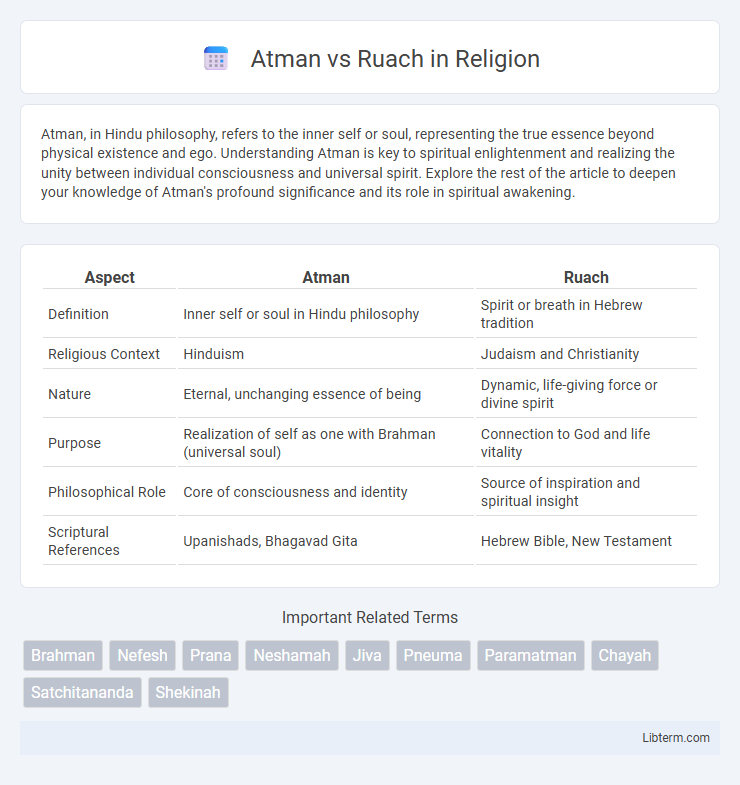Atman, in Hindu philosophy, refers to the inner self or soul, representing the true essence beyond physical existence and ego. Understanding Atman is key to spiritual enlightenment and realizing the unity between individual consciousness and universal spirit. Explore the rest of the article to deepen your knowledge of Atman's profound significance and its role in spiritual awakening.
Table of Comparison
| Aspect | Atman | Ruach |
|---|---|---|
| Definition | Inner self or soul in Hindu philosophy | Spirit or breath in Hebrew tradition |
| Religious Context | Hinduism | Judaism and Christianity |
| Nature | Eternal, unchanging essence of being | Dynamic, life-giving force or divine spirit |
| Purpose | Realization of self as one with Brahman (universal soul) | Connection to God and life vitality |
| Philosophical Role | Core of consciousness and identity | Source of inspiration and spiritual insight |
| Scriptural References | Upanishads, Bhagavad Gita | Hebrew Bible, New Testament |
Understanding Atman: The Essence of Self
Atman, central to Hindu philosophy, represents the true essence of self, embodying pure consciousness and the unchanging soul beyond physical existence. Unlike Ruach, a Hebrew term often signifying spirit or breath associated with life force and divine inspiration, Atman signifies an eternal, immutable core connecting individual identity to universal consciousness. Understanding Atman involves recognizing this inner essence as identical with Brahman, the ultimate reality, thus transcending ego and worldly distinctions.
Ruach: The Breath of Divine Spirit
Ruach, in Hebrew tradition, signifies the divine breath or spirit that animates life and embodies God's presence within the world, distinct from Atman, which refers to the inner self or soul in Hindu philosophy. The concept of Ruach emphasizes movement, wind, and life-force, symbolizing dynamic spiritual energy rather than the static essence of the soul as Atman does. In scriptural texts, Ruach is often portrayed as a living breath that nurtures creation and sustains divine connection, highlighting its role as the active manifestation of divine spirit.
Roots and Origins: Atman in Hinduism, Ruach in Judaism
Atman in Hinduism roots in ancient Vedic scriptures, representing the inner self or soul, considered eternal and the true essence beyond physical existence. Ruach in Judaism originates from Hebrew texts, signifying spirit or breath, often interpreted as divine life force or God's presence within humans. Both concepts emphasize an invisible, vital essence but differ in cultural context and theological interpretation.
Philosophical Context: Concepts of Soul and Spirit
Atman, in Indian philosophy, represents the innermost self or eternal soul, embodying pure consciousness beyond physical existence and individual identity. Ruach, in Hebrew thought, signifies the spirit or breath of life, often viewed as the dynamic force animating living beings and connecting humans to divine essence. Both concepts explore the relationship between individual identity and universal spirit, emphasizing different metaphysical frameworks for understanding the nature of soul and spirit within philosophical traditions.
Atman and Ruach: Etymology and Linguistic Roots
Atman, derived from Sanskrit, signifies the "self" or "soul" in Hindu philosophy, emphasizing individual consciousness and eternal essence. Ruach, stemming from Hebrew, translates as "spirit," "wind," or "breath," embodying divine life force or spirit in biblical texts. Both terms highlight distinct cultural perspectives on internal life force, with Atman focusing on personal eternal spirit and Ruach on universal divine breath.
The Role of Atman in Self-Realization
Atman in self-realization represents the innermost essence or true self beyond the ego and physical existence, serving as the ultimate source of consciousness and spiritual awareness. It is recognized in Hindu philosophy as the eternal, unchanging soul that, when realized, leads to liberation (moksha) from the cycle of birth and death. Understanding Atman facilitates the transcendence of material illusions, enabling the seeker to experience unity with Brahman, the universal absolute.
The Function of Ruach in Spiritual Transformation
Ruach, often translated as "spirit" or "breath" in Hebrew, functions as the vital force driving spiritual transformation by energizing the soul and enabling divine connection. Unlike Atman, which in Hindu philosophy represents the eternal self or inner essence, Ruach emphasizes the dynamic process of renewal and inspiration within the individual. This transformative role of Ruach facilitates ethical awakening, prophetic insight, and purification in biblical spirituality.
Comparative Analysis: Atman vs Ruach
Atman, rooted in Hindu philosophy, represents the innermost self or soul, embodying eternal consciousness and the essence of individual identity beyond physical existence. Ruach, in Hebrew tradition, signifies spirit or breath, often associated with divine inspiration, life force, and the dynamic presence of God within humanity. While Atman emphasizes the immutable, inner self connected to ultimate reality (Brahman), Ruach highlights an active, animating spirit that sustains life and conveys spiritual vitality in relational terms.
Modern Interpretations and Spiritual Practice
Modern interpretations distinguish Atman as the individual soul or true self in Hindu philosophy, while Ruach represents the divine spirit or breath of life in Jewish mysticism. In contemporary spiritual practices, Atman is explored through meditation and self-inquiry to realize unity with Brahman, whereas Ruach is engaged through prayer and mindfulness to connect with God's presence and spiritual vitality. Both concepts emphasize inner transformation, transcending ego to achieve spiritual awakening and deeper consciousness.
Bridging East and West: Integrating Atman and Ruach
Atman, the Sanskrit concept signifying the individual soul in Hindu philosophy, represents the eternal self and ultimate reality, while Ruach in Hebrew tradition denotes spirit or breath, embodying divine life force and inspiration. Bridging East and West requires integrating Atman's inward, meditative self-awareness with Ruach's dynamic, relational spirit, fostering a unified spiritual framework that honors both inner realization and communal connection. This synthesis enriches cross-cultural dialogue by highlighting shared quests for transcendence and the harmonious balance of personal and cosmic dimensions.
Atman Infographic

 libterm.com
libterm.com